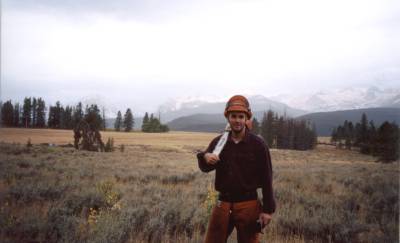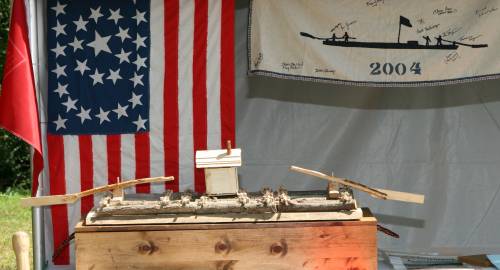by Van Wagner

Photo by Peterson Studio

Log hewing demo available. Photo by Carol Snyder
Van Wagner, songwriter, historian
and Pennsylvania logger has developed a program celebrating the past and
present of the Pennsylvania timber industry. Wagner is a native of the
Danville. He worked for Daniel Logging in Idaho as well as on many
independent logging projects in Pennsylvania. His songs have
been performed all over the world and have been featured in several film
productions. Enjoy this unique program as Wagner takes you on a journey
through Pennsylvania's timber heritage.
This program reviews the past, present
and future of Pennsylvania's Timber heritage. This program covers
how timber was harvested over the past several centuries and most
importantly WHO harvested it. Wagner demonstrates dozens of tools
spanning 200 years of logging history. The program also focuses
on the rafting days when millions of board feet of Pennsylvania Timber
were assembled into various styles of rafts and piloted down our streams
and rivers. Wagner was part of a group who built and piloted a 105
foot timber raft down a section of the North Branch of the Susquehanna
River. It was the first time a raft traveled that portion of water
in a century.
A little bit of music, a little bit of
laughter, and lot of culture make this unique educational program
a reminder of why we should be proud to be from the Timber Country
of Pennsylvania.


Click
here for logging photo's of Wagner in Idaho
Click
here to read the story of the Montour Log Raft
Log Rafting on the North Branch of the Susquehanna
July 2004
Timber Raft Floated Down the North Branch of the Susquehanna for the
First Time In A Century
Although
the logging industry of Pennsylvania was centered around Williamsport and
the West Branch of the Susquehanna River, the North Branch also contributed
a great deal to the story of Pennsylvania timber. The virgin forests
of Penn’s Woods held some of the finest White Pine ever seen. This
species of tree was invaluable to American settlers. The grain of
this tree is straight and true, and it will resist rot and will not warp.
Although very light in weight, it is remarkably strong. Not only
was this resource valued by the naval vessels for masts and spars on ships,
but the farmers Pennsylvania’s southern tier had an insatiable thirst for
wood to construct homes and barns. White Pine floats very well and
was also used to transport goods from the frontier to the markets downstream,
sometimes as far as Baltimore.
The Rafts
There were four kinds of rafts.The first was a “spar raft” which was made by lashing tall straight tree trunks together.Other raft types included; a “timber raft” which was made of squared logs, a “lumber raft” which consisted of logs that had already been sawed into lumber, and lastly “arks” which had a flat bottom and was constructed in a manner to allow for carrying cargo suchas coal, grain, or other goods from the interior. (“The Long Crooked River”)
On several occasions, local iron mills in Danville were forced to use ark rafts to transport their iron T rails and other products due to work stoppages and repair work on the canals and railroads. (Sis Hause)
By 1796,
rafts from both the North and West branches of the Susquehanna were making
the trip downstream, some traveling as far as Norfolk,Va. (S. Stranahan)The
industry quickly escalated over the next decades until the river became
a super-highway of rafts.In 1833 it was certified that from the 18th to
the 23rd day of May, there floated down the North Branch of the Susquehanna,
2688 arks and 3480 rafts.That averages out to over 1000 rafts and arks
per day or between 1 and 2 rafts every minute of the day.Their cargo was
mostly grain and lumber.(Intelligencer 6/14/1833)
The Raftsmen
“Now a Susquehanna waterman…will go on board an ark or a raft somewhere about the New York line, in March, April, and May, descend to the tide water of the Chesapeake, and then return home on foot, through mire, rain, and all sorts of weather, at the rate of 50 or 60 miles a day.When he gets home he jumps upon another ark or raft, and enacts the same feat over again – making five or six trips during the season of high water. “(unnamed observer of 1800’s log rafts)
Later, loggers headed into the headwaters of the Susquehanna for the Eastern Hemlock tree.The bark was used to make tannic acid for Pennsylvania’s thriving tanneries, and the lumber was found to be a very suitable lumber.
A voyage across theAtlantic does not involve so much danger to life and property, as the navigation on the river.This was reaffirmed in March 1938.A group of former lumbermen built a commemorative raft with the intent to navigate it from the small West Branch town of Burnside to Harrisburg.They named the endeavor the “Last Raft.”On the morning of March 20, the raft tied loose from its overnight stay in Williamsport.Later in the day, tragedy struck.The raft, with 48 people aboard, slammed into two bridges between Muncy and Montgomery.Seven people were drowned as the raft tilted and dumped many of the passengers. The raft did continue towards its destination and was eventually tied off about 8 miles above Harrisburg and the timber sold to a lumber buyer.
Other
attempts to construct and float a log raft have occurred since the "Last
Raft," although none on the North Branch.These other rafts include one
built by Lycoming College students in 1964, a raft on the West Branch in
1976, and another raft on the West Branch in March-April of 2004 to commemorate
the bicentennial of Clearfield County.
A 21st Century Raft on the River - A Timeline
2003 - Sometime during 2003, Van Wagner and Karl Shellenberger came up with the idea of building a log raft similar to those that were used to transport timber to downstream markets in the 1700s and 1800s.
early 2004 - Van and Karl began researching the history and construction techniques of log rafts. This included a trip to the Lycoming County Historical Society Museum, where we obtained excellent information on the construction of the Last Raft of 1937.
May-July 14 2004 - logs and other construction materials were obtained and the raft was constructed at the Bill Shultz farm (upstream of Danville). Construction of the raft was accomplished through the hard work of many people: Van Wagner, Ken Kremser, Aaron Myers, Mark Lewis, Sonia Guediche, Francy Moyer...
July 15, 2004 - Raft is tied loose from the shore at the Shultz Farm and floated to just past the Danville River Bridge so that people could see the raft during the Iron Heritage Festival.
July 18, 2004 - Raft is once again tied loose and floated a few more miles downstream to a location in Point Township, Northumberland County.
July 22, 2004 - Raft is tied loose again and floated downstream to near the border of Upper Augusta Township and Rush Township, Northumberland County.
July 28, 2004 - Raft gets hit by a log during a period of high water and takes off downstream. A group of firefighters and Ken Kremser were able to rescue the raft. Without that, it may have hit the fabridam in Sunbury. Dams were not a hazard that the oarsmen had to deal with back in the 1800s. The raft ended its journey at Packers Island in Sunbury.
August
8, 2004 - The raft is deconstructed and the logs will become lumber.
Montour Raft Statistics
Length - 105 feet (including tiller blades), abbooutt 75 feet not counting the tillers
Width - Varied, averaged about 15 feet
Estimated Weight - 20-25 tons
Total Lumber Contained in Raft - about 5000 board feet
Total Days of Travel - 4
Total
Distance of Travel - about 15 miles
Sources
Sis Hause, Danville Historian.Danville, PA
S. Stranahan.“Susquehanna: River of Dreams”John Hopkins University Press, 1993.
The Danville Intelligencer Newspaper, Danville PA 6/14/1833
Myers, Richmond E “The Long Crooked River”. (The Susquehanna) Boston,(1949) The Christopher Publishing House.
.
Links to other Log Rafting Information
Clearfield County Bicentennial Log Raft.
Logging Raft History (Allegheny National Forest area)
An old Boy Scout guide to canoeing on the West Branch from Clearfield to North Bend can be found here. It may take a while to load, but it is very interesting reading and has some great information about the history of the river.
Minutes from a DCNR Meeting with a presentation of Logging History
Acknowledgements
This project would not be possible without the help and donations from the following:
Lori Sandahl, Elysburg
Siegel Lumber Company, Pine Grove
Sandra B. Rife, Director and Scott Sagar, Curator of Collections Lycoming County Historical Society Musueum
Sis Hause, Danville
Bill and Si Bailey, Benton
Bill Shultz, Danville
Harris
Taxidermy Studio, Danville
BOOK NOW AVAILABLE!! (Click
on one of the links below)
HTML
website
Word
(.doc)Format
Adobe
(.pdf) Format